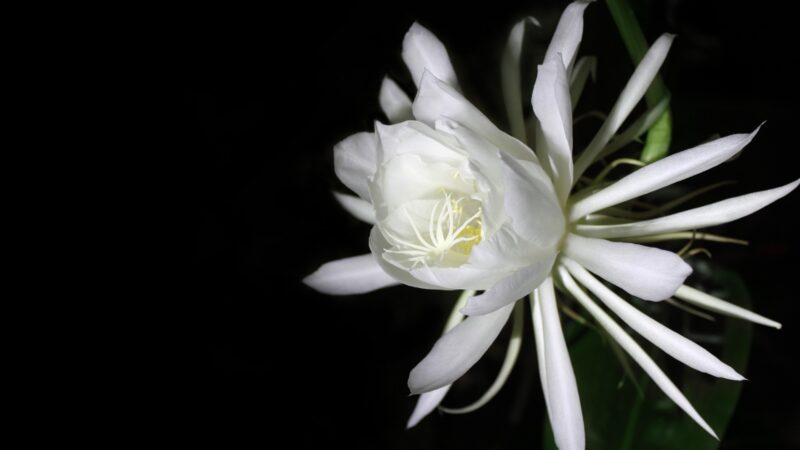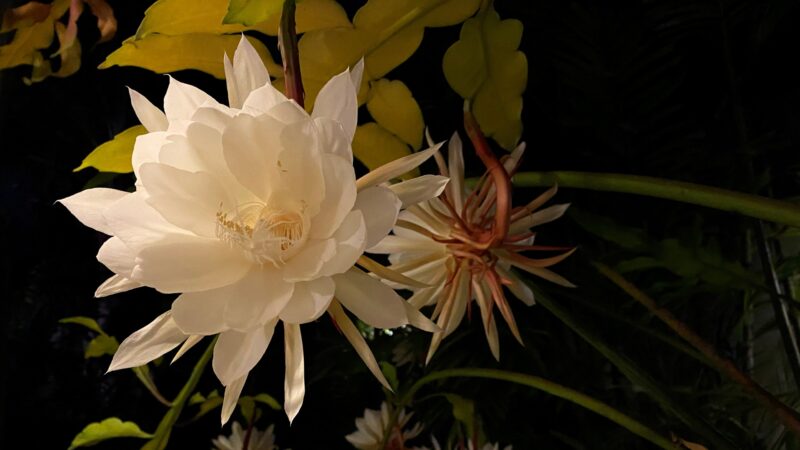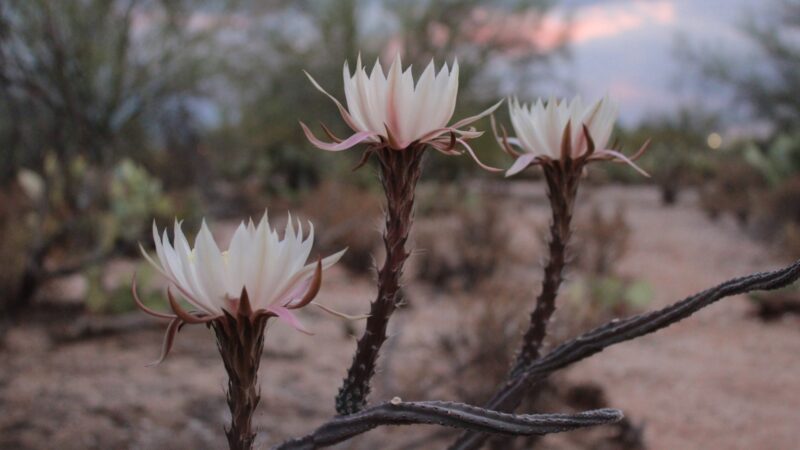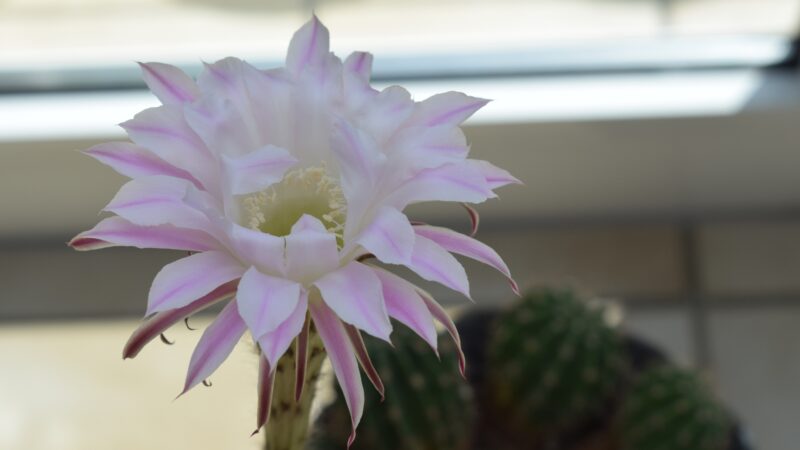Also called the Dutchman’s Pipe Cactus, the Queen of the Night is famously known for its blooming habit, which only occurs at night, once a year.
This plant is a tropical orchid cactus that produces white flowers and edible, purplish red fruits. They can be used in container planting with the right care.
Plant it in moist, well-draining loam or sandy soil, then place it in a location where it can receive partial shade or bright, indirect light. Water thoroughly and frequently but allow the soil to dry out in between waterings. Feed with fertilizer only during the growing season or when repotting.
To know more about the queen of the night, why it blooms the way it does, what are the environmental conditions it requires, and other interesting information, read further this article!
Queen of the Night Flower | All You Need to Know!

What Is Queen of the Night Flower?
Queen of the night (Epiphyllum oxypetalum) is a night-blooming orchid cactus that produces large, showy, fragrant white flowers that open only one time.
This plant grows on the surface of another species and then sequesters nutrients and moisture from the air, rain, and debris that are accumulating on the species they live in.
When it is in its native habitat, it can be found growing on trees. However, it can also be grown and maintained easily in containers.
In fact, the queen of the night is the most cultivated species in the cactus family due to its fast growth. It is also used for its medicinal properties, specifically in traditional medicine, in Asian countries.
Why Is It Called Queen of the Night?
This plant is known to bloom a white flower for one single night only, releasing a fragrant scent the entire period before promptly closing or wilting at dawn.
Types of Queen of the Night Flower
1. Red Orchid Cactus (Epiphyllum ‘Fifty Grand’)
This variety is characterized by its large, deep rosy-pink, star-shaped flowers. It grows 1 to 2 feet tall with flat, wide, scalloped branches and is great for planting in hanging baskets, especially when displayed outdoors during the summer season.
2. Pink Orchid Cactus (Epiphyllum ‘Thousand Pinks’)
Growing up to a height of 2 to 3 feet, this beautiful variety is a prolific grower that can produce some pink flowers over a long period of time. This cultivar is resistant to wilt and only needs occasional watering, making it a fairly easy plant to maintain.
3. Hooker’s Orchid Cactus (Epiphyllum hookeri)
Found in forests, usually in dry to moist coniferous-hardwood, this perennial species blooms yellowish-green flowers from late May until late July. It also produces erect fruits after its flowers bloom.
4. Peruvian Apple Orchid (Cereus repandus)
An upright, succulent perennial that requires the same care as the queen of the night, this species is used for container planting, large patios, and rock gardens. Its white flowers are large, and it also develops red, globose fruits.
Where Do the Flower Queen of the Night Bloom?
The queen of the night is native to Southern Mexico and in some areas in South America. In its native habitat in temperate forests and primary rainforests with tropical climate zones, you can see the plant growing on trees.
Why Does the Queen of the Night Plant Only Bloom at Night?
This is due to the timing of their pollination. Since their main pollinators are bats, which are nocturnal animals, the plant would only bloom at night when it is pollinated by the animals.
Interesting Facts About the Queen of the Night Flower
- Colonies of the queen of the night flowers bloom on the same night annually. Although no scientific consensus has been reached as to why this happens, it is speculated that the timing of pollination along with their environmental conditions may be the reasons why.
- For the rest of the year, this plant looks like a gray stick with spindles that can barely even support itself.
- The telltale sign that the flower is about to bloom is when the buds begin to soften and show a sliver of white.
- It does not have true leaves. Instead, their leaf-like structures are flattened stems that can easily be rooted.
When Does the Queen of the Night Flower Bloom?

Usually during summer nights in either June or July. However, it can bloom as late as the fall season.
How Long Does Queen of the Night Flower Last?
The queen of the night blooms only one night a year, sometime between the summer to fall seasons.
How to Get the Queen of the Night Flower to Bloom?
Provide the plant with direct, morning light or bright, indirect light to encourage it to bloom. You can also try feeding it as early as January until October to make sure it blooms early.
How to Grow Queen of the Night Flower From Seed?
Step 1: Weaken the seed coating of the plant’s seeds by nicking or breaking its outer coating. This speeds up the germination process as it allows the seedling to sprout through an opening.
Step 2: Soak it in lukewarm water before placing it in the refrigerator for about 4 to 6 weeks.
Step 3: Insert seeds into a container or pot filled with a good potting mix. It should be well-draining and preferably loamy.
Step 4: Place the plant in a location where it can receive bright but indirect sunlight.
Step 5: Waiting time takes several weeks to months as long as you keep the plant in optimal living conditions. Allow it to receive humidity and moisture but not to the point where it is excessively wet, and temperatures of 70°F to 80°F.
How to Take Care of a Queen of the Night Flower?
Lighting
This plant grows best in bright, indirect light or partial shade. It should receive at least 6 hours of direct sun exposure daily.
Water
Despite being a cactus orchid, the queen of the night is used in rainforest environments, which means they require more water than most cacti species. Water frequently and thoroughly, but let the upper layer of the soil dry out in between waterings.
Temperature and Humidity
The queen of the night grows best in USDA Zones 10 to 11, which are characterized by temperatures of 30°F to 50°F. It is tolerant to high levels of humidity.
Soil
Grows best in moist but well-drained loam or sandy soil filled with organic matter. When planting in containers, using a cactus soil mix is sufficient.
Fertilizer
Feed during the growing season using a liquid fertilizer or when repotting using a slow-release fertilizer. Avoid fertilizing during the winter season.
Potting and Repotting
Queen of the nights grows in any type of pot, may it be porous, semi-porous, or nonporous, as long as it has drainage holes and receives adequate moisture.
In the first few years of its growth, repotting isn’t necessary. However, if the plant grows too big as if it’s going to tip over, repot in a new container.
How to Propagate Queen of the Night Flower?

Step 1: The queen of the nights is propagated through stem cuttings. The best time to take them is in the early morning when the plant is fully turgid.
Step 2: Select a cutting only from the current or past season’s growth. Avoid cutting any flower buds as much as possible. If you happen to accidentally include them, remove them.
Step 3: Use pruning shears or a sharp knife to cut the stem at 4 to 6 inches long.
Step 4: Remove lower leaves, then treat the end of the cutting with the rooting hormone. When using powdered formulations, tap the cuttings to remove any excess rooting hormone on them.
Step 5: Insert one-third to one-half of the length of the cutting into a sterile, well-drained, and sufficiently aerated rooting medium. You can use a 50:50 ratio of peat and sand or peat and perlite.
Step 6: Once they have grown a root system, transplant them into a garden bed or containers.
How to Preserve the Queen of the Night Flower?

Simply place the stem in a glass, jar, or other container filled with water, then place it inside your refrigerator. It is guaranteed that it will remain open the following day.
Common Problems With Queen of the Night Flower
Overwatering. This causes yellowing, mushy leaves, and stems. If left untreated, the leaves will start dropping off, and the soil surface can start developing fungus or mold gnats.
Underwatering. Orchid cactus generally do not need a lot of water since they can store it in their leaves. However, if they are underwatered, leaves will turn brown, shrivel up, and drop off. Roots may also die, which means the plant will have a hard time recovering.
Root Rot. This is a consequence of overwatering, which causes roots to die. When it is left untreated, the plant may never recover.
Insufficient Light. Although growing tall and spindly is the common growth appearance of the queen of the night, if they are paler in color than usual, chances are the light it receives is insufficient.
Sun Damage. Symptoms are tan or brown patches forming on the stems or leaves. It is generally caused by suddenly transferring the plants from low light level conditions to bright or direct sunlight exposure.
What Does Queen of the Night Flower Symbolize?
The queen of the night is usually associated with luck and success in other countries.
Is the Queen of the Night Plant Poisonous?
Although there are no official sources stating that this plant is poisonous, it is, nonetheless, suggested to keep it out of the reach of children and pets since ingesting its leaves or any plant material can lead to negative health effects, such as nausea and vomiting.
Does Queen of the Night Produce Fruit?
Queen of the night does produce fruit. In fact, they are edible. Once they are pollinated, they produce oblong, purplish red fruits.